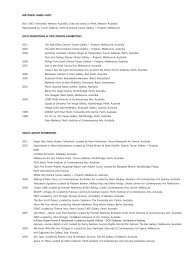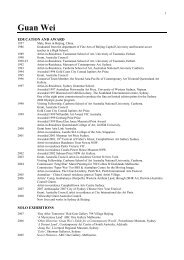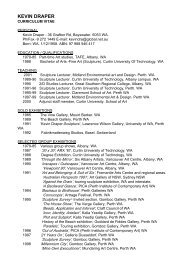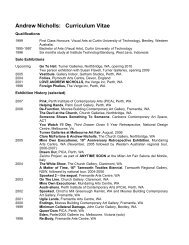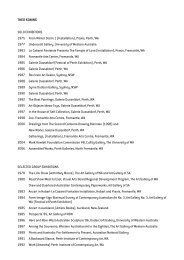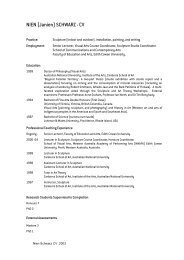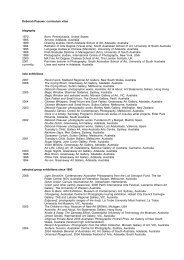to catch a herring catalogue - Turner Galleries
to catch a herring catalogue - Turner Galleries
to catch a herring catalogue - Turner Galleries
Create successful ePaper yourself
Turn your PDF publications into a flip-book with our unique Google optimized e-Paper software.
<strong>to</strong> the stark duality of Piranesi’s abstract geometrical structures. The almostexaggerated clarity of his forms is the result of orthogonal projections whoselines of sight, according <strong>to</strong> The Australian Engineering Drawing HandbookPaul uses, ‘are parallel <strong>to</strong> each other (station point at an infinite distance fromthe projection plane), and perpendicular <strong>to</strong> the projection place. The objectmust be oriented such that a principal axis is perpendicular <strong>to</strong> the projectionplane.’ Through such a method Paul avoids the convergence of sight linesupon the eye of the viewer that gives even the multiplied perspectives ofCubism the sense of a world set up <strong>to</strong> coincide with our own unique positionin space. A Round Mirror (p.13), for example, is devised so as <strong>to</strong> give what themanual would call ‘the best overall description of the object’, especially sinceits ‘<strong>to</strong>p’ has been removed <strong>to</strong> hang by its side so as <strong>to</strong> show both its interiorand how its form might be completed. Within a diagrammatic space our eyesare constantly invited <strong>to</strong> place the ‘lid’ on the form and take it off again, butthe reversed canvas also ensures that these objects are perceived as realobjects hanging on the wall. It is their orthogonal projection that puts Paul’sforms in<strong>to</strong> ‘a world of their own’ which sharpens the paradox of them hangingso substantially in our world of real space.do not lay in wait like traps, but come out at you in double directions like flatand hollow fingers constructing a mathematical space our bodies don’t quiteshare. The White Owl (p.29), the last work in the show, appeals <strong>to</strong> our memoryas a dog-eared page whose colour recalls the buried passions obliquelysignified by the red series. It’s the only work that purports <strong>to</strong> show, not theinterior but the back of its own structure, folded over as a casual, falliblecrease upon a utilitarian logic. Through the writing of this essay the his<strong>to</strong>ry ofreversed canvases has helped me <strong>to</strong> define Paul’s works by contrast ratherthan analogy, yet what Paul calls these ‘constructed canvases’ do seem <strong>to</strong>offer a fundamental questioning of the nature of painting by stepping asidefrom it and exposing its infrastructure.Richard ReadIf all the works in the show possess a family resemblance, it is because theyshare a common light source at <strong>to</strong>p right. This, Paul points out, showing moreof his mild optimism, is where the sun rises. The engineering mode alsoreflects structural package designs, but not in any garrulous Pop Art sense.There is a functionality in the remote suggestion of a periscope in A LargeWindow (p.11), of a geodesic dome in A Round Mirror and in the ‘S-bend’of No Answer, but they are machines whose real efficiency is the generationof artistic paradox. The clarity, rationality, and fuctionality of the engineeringmode sharpens the duality of playful comedy that liberates it in<strong>to</strong> art. Withoutthe industrial rigour the paradoxical mystery would not be so keenly felt.The <strong>herring</strong> in the series called ‘. . . <strong>to</strong> <strong>catch</strong> a <strong>herring</strong>’ (p.21-27) is clearly a redone, whatever the actual colour. The grey and the red series flipped resolutelyin<strong>to</strong> and out of illusion. These hover much more tensely between contradic<strong>to</strong>ryvolumes, open at the bot<strong>to</strong>m, closed at the <strong>to</strong>p. The artifice shows all alongthe length of the illusions because, unlike the other series, there are no‘cover straps’ <strong>to</strong> hold the canvas above the staples that here press throughit. You’re supposed <strong>to</strong> see the staples pressing through the canvas. If theyeschew functionality, such effects also shaft the ideology of pure art, while thediscordant colours set up a clash between ordered and random principles ofcomposition. Hence the depth of the diagonal strips from the perpendicularis calculated by a regular ratio while their length is determined by throws ofa dice. Taken from an Atelier colour chart, the closed upper ends are tints,the <strong>to</strong>ps of the strips are pure colour and the sides are shades. Their coloursblare like the upper and lower register of truck horns, though they also streamlike taillights in a pho<strong>to</strong>graph. The titles are paradoxical again, for the works



